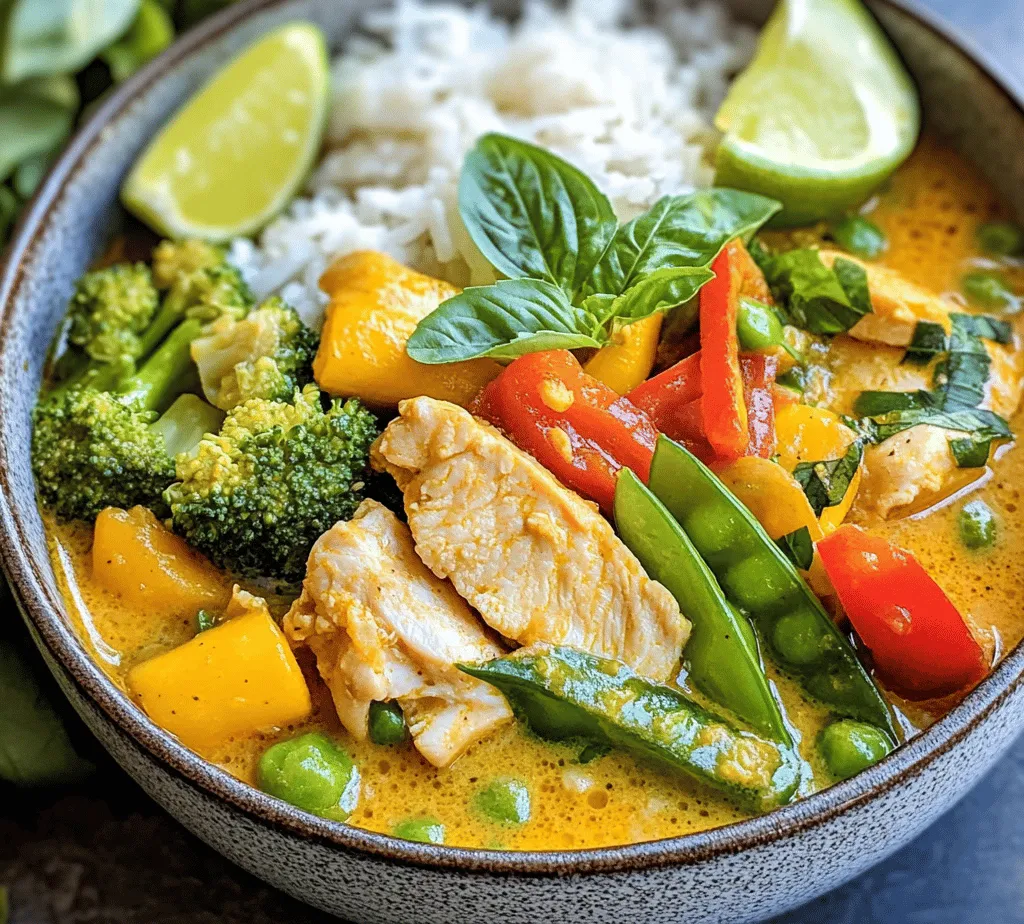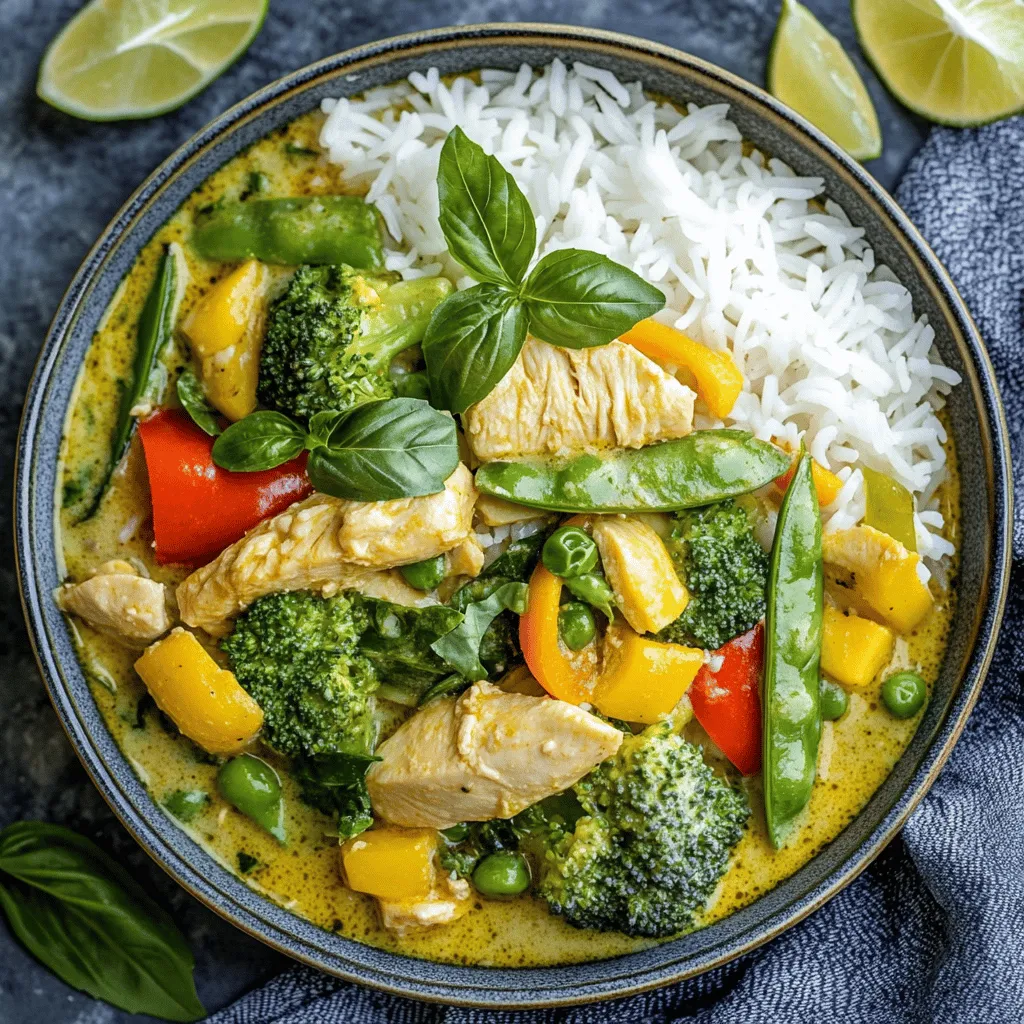Introduction
Thai cuisine has captivated the hearts and palates of food enthusiasts around the world, celebrated for its vibrant flavors, aromatic spices, and a harmonious balance of sweet, salty, spicy, and sour. Among the most cherished dishes in Thai gastronomy is Thai Green Curry, a delightful concoction that embodies the essence of Thailand. This dish not only showcases the country’s rich culinary heritage but also highlights its commitment to fresh ingredients and bold flavors.
Thai Green Curry is more than just a meal; it is a symbol of the Thai culinary philosophy, where each component plays a pivotal role in creating a delightful symphony of tastes. Its popularity extends beyond Thailand’s borders, making it a staple in Thai restaurants globally, and even inspiring home cooks to recreate its magic in their kitchens. What makes this dish particularly appealing is its simplicity and versatility. Whether you prefer the traditional chicken variant, a vegetarian option, or even a seafood twist, Thai Green Curry can be tailored to suit various dietary preferences and tastes.
Moreover, the ingredients used in this dish contribute not only to its flavor but also to its nutritional profile. Fresh vegetables, lean protein, and creamy coconut milk all come together to create a dish that is as wholesome as it is delicious. In this article, we will explore the origins of Thai Green Curry, delve into its key ingredients, and guide you through the step-by-step process of creating this delightful dish at home.
Understanding Thai Green Curry
The roots of Thai Green Curry can be traced back to the central regions of Thailand, where it has evolved into a dish that reflects the local culture and the bounty of the land. Traditionally, green curry is known as “Gaeng Khiao Wan,” which translates to “sweet green curry.” The name is derived from the vibrant green color of the curry paste, which is made from fresh green chilies, herbs, and spices, giving it a slightly sweet yet spicy flavor profile.
Cultural significance plays a vital role in this dish. Thai Green Curry is often served during special occasions and family gatherings, symbolizing unity and togetherness. The dish is not just a source of sustenance; it is a representation of love and care put into preparing a meal for others.
What defines a great Thai curry is its balance of flavors and textures. A well-made green curry should have a rich, velvety sauce, tender meat, and an array of colorful vegetables that bring both nutrition and visual appeal. The use of fresh ingredients is paramount in achieving an authentic taste, as they contribute to the aromatic qualities that Thai cuisine is known for. The freshness of the herbs, the quality of the curry paste, and the ripeness of the vegetables all play a crucial role in enhancing the overall flavor of the dish.
Ingredients Breakdown
Creating a delicious Thai Green Curry begins with selecting the right ingredients. Each component adds depth and character to the dish, making it essential to use high-quality products whenever possible. Here’s a detailed explanation of the key ingredients you will need for your Thai Green Curry Delight:
1. Green Curry Paste
The heart of this dish lies in the green curry paste, which is a blend of green chilies, garlic, shallots, lemongrass, galangal, and a variety of herbs. The paste is what imparts the distinct flavor and vibrant color to the curry. When choosing green curry paste, opting for a high-quality product is essential. Look for brands that use fresh ingredients without preservatives for the best flavor. Alternatively, you can make your own paste at home for an extra layer of authenticity.
2. Chicken
Chicken is a popular protein choice for Thai Green Curry, as it absorbs the flavors of the curry beautifully. For this recipe, boneless, skinless chicken thighs are recommended for their tenderness and juiciness. However, you can also use chicken breast or even substitute it with tofu, tempeh, or seitan for a vegetarian or vegan version.
3. Coconut Milk
Coconut milk is a signature ingredient in Thai curries, providing a creamy texture and rich flavor that balances the spiciness of the curry paste. Full-fat coconut milk is ideal for a luxurious sauce, while light coconut milk can be used for a healthier option. The creaminess of coconut milk also adds to the dish’s comfort factor, making it a favorite among many.
4. Vegetables
A variety of fresh vegetables can be included in your Thai Green Curry, such as bell peppers, bamboo shoots, eggplant, and zucchini. These vegetables not only add color and texture but also contribute essential vitamins and minerals, making the dish more nutritious. Feel free to customize your vegetable selection based on your preferences or seasonal availability.
5. Fresh Herbs
Fresh basil, particularly Thai basil, is often added at the end of cooking for a burst of flavor. Its unique aroma and slight anise flavor enhance the curry and add freshness. Other herbs like cilantro can also be used as a garnish to elevate the dish further.
6. Fish Sauce
Fish sauce is a staple in Thai cuisine, providing a salty, umami flavor that brings depth to the dish. If you are cooking for someone who is vegetarian or does not consume fish, soy sauce or tamari can be used as a substitute.
7. Lime Juice
A splash of fresh lime juice at the end of cooking adds brightness to the curry and balances the flavors. The acidity from the lime helps cut through the richness of the coconut milk, making each bite refreshing.
Nutritional Benefits
The ingredients in Thai Green Curry provide a range of health benefits. Chicken is a great source of lean protein, essential for muscle repair and overall health. The vegetables contribute fiber, vitamins, and minerals, supporting digestive health and boosting immunity. Coconut milk, while higher in calories, contains medium-chain triglycerides (MCTs) that can provide energy and support metabolism when consumed in moderation.
For those with dietary restrictions, this recipe is easily adaptable. You can replace chicken with tofu for a plant-based version or omit fish sauce for a vegan-friendly meal. The versatility of this recipe allows you to cater to various diets while still enjoying the delicious flavors of Thai cuisine.
Step-by-Step Instructions
Now that we have a solid understanding of the ingredients and their significance, it’s time to move on to the preparation of this delectable dish. A Thai Green Curry is traditionally served with jasmine rice, which complements the rich curry perfectly. Let’s start by preparing the jasmine rice, a fundamental aspect of Thai cuisine.
Preparing the Jasmine Rice
Jasmine rice is a long-grain rice known for its fragrant aroma and slightly sticky texture when cooked. It is the perfect accompaniment to Thai Green Curry, as it absorbs the flavors of the sauce beautifully. Here’s how to prepare it:
1. Rinse the Rice: Begin by measuring out the desired amount of jasmine rice (typically one cup serves about two people). Rinse the rice under cold water until the water runs clear to remove excess starch. This step prevents the rice from becoming too sticky during cooking.
2. Cook the Rice: In a pot, combine the rinsed rice with water in a 1:1.5 ratio (1 cup of rice to 1.5 cups of water). Bring the mixture to a boil over medium heat. Once boiling, reduce the heat to low, cover with a lid, and let it simmer for about 15 minutes. Avoid lifting the lid during cooking, as this can release steam and affect the cooking process.
3. Fluff and Serve: After 15 minutes, remove the pot from heat and let it sit, covered, for an additional 5 minutes. This resting period allows the rice to finish cooking. Finally, fluff the rice with a fork and serve alongside your Thai Green Curry.
Importance of Rice in Thai Cuisine
Rice is a staple food in Thailand, often considered the foundation of every meal. It is not just a side dish but a vital component that complements the flavors of curry and other dishes. The texture of jasmine rice balances the richness of the curry, making each bite a harmonious experience.
Heating the Oil
Once your rice is prepared, it’s time to start cooking the Thai Green Curry. Begin by heating the oil in a large skillet or wok over medium-high heat. The type of oil you choose can influence the flavor of your dish.
– Choosing the Right Type of Oil: For Thai cooking, oils with high smoke points like vegetable oil, canola oil, or coconut oil are recommended. These oils will withstand the heat without burning and will complement the flavors of the curry.
Cooking the Chicken
Next, add your chicken to the heated oil.
– Techniques for Ensuring Chicken is Tender and Flavorful: Cut the chicken into bite-sized pieces to ensure even cooking. Sear the chicken for about 5-7 minutes until it is golden brown on all sides. This browning process not only adds flavor but also locks in moisture, keeping the chicken tender.
Making the Curry Base
After your chicken is cooked, it’s time to build the curry base.
– Importance of Sautéing Curry Paste: Add the green curry paste to the pan, stirring it into the chicken for about 2-3 minutes until fragrant. Sautéing the curry paste releases the essential oils and flavors from the spices, enhancing the overall taste of the dish.
Next, add the coconut milk and broth to the pan to create the sauce.
– Adding Coconut Milk and Broth: Pour in the coconut milk and chicken or vegetable broth, stirring to combine. The ratio of coconut milk to broth can be adjusted based on your preferred creaminess level. Bring the mixture to a gentle simmer, allowing the flavors to meld together.
As the curry simmers, the aroma will fill your kitchen, transporting you to the vibrant streets of Thailand with every whiff.
This part of the article outlines the foundational aspects of preparing a Thai Green Curry Delight, setting the stage for a delicious culinary experience. Stay tuned for the next section, where we will explore additional steps to finish the curry, along with serving suggestions and tips for the best results.

The role of coconut milk in creating a creamy texture
Coconut milk is a cornerstone in Thai green curry, providing a rich, creamy texture that elevates the dish beyond mere ingredients. This unique milk, extracted from the flesh of mature coconuts, brings not just creaminess but also a subtle sweetness that enhances the overall flavor profile. When combined with the vibrant green curry paste, the coconut milk helps to mellow the heat, creating a delightful balance that allows the spices to shine without overwhelming the palate.
The incorporation of coconut milk also contributes to the dish’s luxurious mouthfeel, making each bite a creamy delight. To achieve the best results, opt for full-fat coconut milk, which adds richness and depth. Light coconut milk can be used for a lighter version, but be mindful that it may affect the overall flavor and texture.
Flavoring the Curry
The true magic of Thai green curry lies in the harmony of its flavors. After adding coconut milk, the next step is to infuse the curry with aromatic ingredients. Begin by stirring in the green curry paste, which is typically made from a blend of green chilies, garlic, lemongrass, galangal, and shallots. This paste is where the dish gets its characteristic heat and depth of flavor.
As the mixture simmers, introduce fish sauce and a touch of brown sugar to enhance the curry’s complexity. Fish sauce adds a salty umami depth, while brown sugar balances the heat and acidity with a hint of sweetness. The combination of these ingredients creates a well-rounded flavor that is signature to Thai cuisine. Remember to taste and adjust seasoning as needed; a little more fish sauce or sugar can make a noticeable difference.
Including the Vegetables
Vegetables are not just an accompaniment; they are essential for adding texture, color, and nutrition to your Thai green curry. Common choices include bell peppers, zucchini, baby corn, and eggplant, but feel free to incorporate any of your favorites or seasonal vegetables.
The nutritional value of selected vegetables cannot be overlooked. For instance, bell peppers are rich in vitamins A and C, while zucchini adds fiber and hydration. Baby corn is low in calories and high in antioxidants, making it a great addition. Eggplant, on the other hand, contributes valuable antioxidants and a unique texture that absorbs the curry’s flavors beautifully.
Cooking tips to maintain vibrant color and crunch
To maintain the vibrant color and crunch of the vegetables, it’s essential to avoid overcooking. When adding them to the simmering curry, do so in stages based on their cooking times—start with the vegetables that take longer to cook, like eggplant, and add quicker-cooking ones, such as bell peppers, later.
A good rule of thumb is to cook the vegetables until they are just tender but still have a slight crunch. This not only preserves their nutrients but also ensures that the curry is visually appealing, creating a feast for both the eyes and the taste buds.
Finalizing the Dish
Once the vegetables are cooked to perfection, it’s time to combine all components for a harmonious flavor profile. Stir in your choice of protein, allowing it to absorb the flavors of the curry. If using chicken, ensure that it is cooked through, while tofu or shrimp should be added toward the end to prevent overcooking.
The final touch is to garnish the dish with fresh herbs like Thai basil or cilantro, which contribute an aromatic freshness that brightens the dish. A squeeze of lime juice just before serving can also enhance the flavors, providing a delightful contrast to the richness of the coconut milk.
Importance of garnishing for presentation and flavor
Garnishing is not just for aesthetics; it enhances the overall dining experience. Fresh herbs, lime wedges, and even slices of red chili can add a pop of color that makes the dish visually enticing. They also contribute fresh flavors that can elevate each bite, making every spoonful exciting.
Serving Suggestions
Best practices for serving Thai Green Curry
When it comes time to serve your Thai green curry, presentation matters. Serve the curry in a deep bowl to hold the rich sauce and arrange the vegetables and protein artfully to showcase their vibrant colors. A sprinkle of fresh herbs on top not only adds to the visual appeal but also invites diners to enjoy the aromatic experience that comes with each bite.
Pairing with jasmine rice and lime wedges
Thai green curry is traditionally served with jasmine rice, which is ideal for soaking up the flavorful sauce. The lightly fragrant rice complements the rich curry without overpowering it. Additionally, providing lime wedges on the side allows guests to customize their dish with a squeeze of fresh lime juice, which brightens the flavors beautifully.
Ideas for additional side dishes or accompaniments
For a complete meal, consider offering additional side dishes. A simple cucumber salad dressed with rice vinegar and sugar can provide a refreshing contrast to the richness of the curry. Spring rolls or satay skewers can also be delightful accompaniments, creating a well-rounded Thai dining experience.
Variations of Thai Green Curry
Exploring different proteins (tofu, shrimp, etc.)
One of the best aspects of Thai green curry is its versatility. While chicken is a popular choice, other proteins can be used to suit different dietary preferences. Tofu is an excellent plant-based alternative that absorbs the flavors of the curry well. Shrimp, scallops, or even beef can also be delicious options, each bringing their distinct texture and flavor to the dish.
Vegetarian and vegan adaptations
For those seeking vegetarian or vegan adaptations, simply replace the fish sauce with soy sauce or tamari, and ensure that the coconut milk is free from any additives. The use of hearty vegetables and plant-based proteins like chickpeas or tempeh can provide satisfying alternatives without sacrificing flavor.
Customizing spice levels to suit personal taste
Thai green curry can be easily customized to suit individual spice preferences. If you prefer a milder flavor, use less green curry paste or opt for a sweeter variety. For those who crave heat, consider adding extra chilies or serving with a chili sauce on the side. This adaptability allows everyone to enjoy the dish at their preferred spice level.
Seasonal variations using local vegetables
Another way to vary your Thai green curry is by incorporating seasonal, locally sourced vegetables. In the spring, consider adding snap peas and asparagus, while summer offers an abundance of zucchini and cherry tomatoes. Fall vegetables like butternut squash or sweet potatoes can provide a new twist, while winter greens like kale can add heartiness to the dish.
Health Benefits of Thai Green Curry
Nutritional analysis of the main ingredients
Thai green curry is not just delicious; it can also be healthy. The primary ingredients—coconut milk, vegetables, and protein—offer various health benefits. For instance, coconut milk contains medium-chain triglycerides (MCTs), which are known to provide a quick source of energy. Additionally, the vegetables contribute essential vitamins, minerals, and dietary fiber, promoting overall health and digestion.
Benefits of herbs and spices commonly used in Thai cooking
The herbs and spices in Thai cooking, such as lemongrass, galangal, and kaffir lime leaves, are not only flavorful but also provide health benefits. Lemongrass is known for its anti-inflammatory properties, while galangal has been used for its digestive benefits. Incorporating these fresh ingredients into your diet can enhance not only flavor but also health.
How this dish can fit into a balanced diet
When enjoyed in moderation, Thai green curry can fit well into a balanced diet. By using lean proteins and a variety of vegetables, you can create a nutrient-dense meal. Pairing it with whole grain rice increases fiber content, making it a wholesome option that satisfies and nourishes.
Conclusion
In summary, Thai Green Curry Delight is a simple yet incredibly flavorful dish that showcases the beauty of Thai cuisine. Its creamy texture, vibrant vegetables, and aromatic spices create a harmonious balance that is both comforting and exciting. The versatility of this recipe allows for personal adaptations, ensuring that everyone can enjoy a version tailored to their tastes.
I encourage you to try making this delightful dish at home, whether you’re a seasoned chef or a novice in the kitchen. The joy of cooking and sharing a meal with loved ones is unparalleled, and there’s nothing quite like the satisfaction of serving a homemade Thai green curry. Embrace the process, enjoy the flavors, and share this culinary experience with those you cherish.



